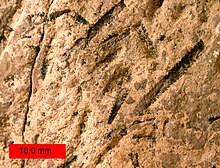Hemichordate: Difference between revisions
m robot Adding: uk:Напівхордові |
Xenopleura (talk | contribs) No edit summary |
||
| Line 31: | Line 31: | ||
==External links== |
==External links== |
||
* [ |
* [hhttps://www.webdepot.umontreal.ca/Usagers/cameroc/MonDepotPublic/Cameron/index.htm Cameron, C. B. ''Evolution and classification of hemichordata''] |
||
* [http://tolweb.org/tree?group=Hemichordata&contgroup=Deuterostomia At the Tree of Life] |
* [http://tolweb.org/tree?group=Hemichordata&contgroup=Deuterostomia At the Tree of Life] |
||
[[Image:DiplograptusCaneySprings.jpg|thumb|left|''Amplexograptus'', a [[graptolite]] hemichordate, from the [[Ordovician]] near [[Caney Springs, Tennessee|Caney Springs]], [[Tennessee]].]] |
[[Image:DiplograptusCaneySprings.jpg|thumb|left|''Amplexograptus'', a [[graptolite]] hemichordate, from the [[Ordovician]] near [[Caney Springs, Tennessee|Caney Springs]], [[Tennessee]].]] |
||
Revision as of 20:46, 25 October 2009
| Hemichordate | |
|---|---|

| |
| Acorn worm, a hemichordate. | |
| Scientific classification | |
| Kingdom: | |
| Subkingdom: | |
| Superphylum: | |
| Phylum: | Hemichordata Bateson, 1885
|
| Classes | |
Hemichordata is a phylum of worm-shaped marine deuterostome animals, generally considered the sister group of the echinoderms. They date back to the Lower or Middle Cambrian and include an important class of fossils called graptolites, most of which became extinct in the Carboniferous.
Structure
They seem to have a primitive form of notochord, formed from a diverticulum of the foregut called a stomochord, but this is most likely the result of convergent evolution rather than homology with the vertebrate notochord. A hollow neural tube exists among some species (at least in early life), probably a primitive trait they share with the common ancestor of chordata and the rest of the deuterostomes.
The bodies of Hemichordates are divided into three parts, proboscis, collar and trunk. They have open circulatory systems and a complete digestive tract but the musculature in their gut is very poorly developed, and food is mostly transported through it by using the cilia that cover its inside surface.
Classification
Hemichordata are divided into two classes: the Enteropneusta,[1] commonly called acorn worms, and the Pterobranchia, which may include the graptolites. A third class, Planctosphaeroidea, is proposed based on a single species known only from larvae. The phylum contains about 100 living species. Hemichordata appears to be sister to the Echinodermata as Ambulacraria; Xenoturbellida may be basal to that grouping. Pterobranchia may be derived from within Enteropneusta, making Enteropneusta paraphyletic.
References
- ^ Attention: This template ({{cite pmid}}) is deprecated. To cite the publication identified by PMID 19348951, please use {{cite journal}} with
|pmid=19348951instead.
External links
- [hhttps://www.webdepot.umontreal.ca/Usagers/cameroc/MonDepotPublic/Cameron/index.htm Cameron, C. B. Evolution and classification of hemichordata]
- At the Tree of Life

